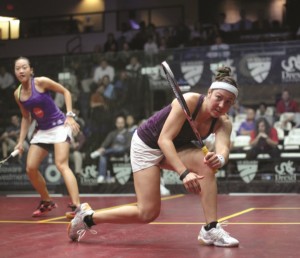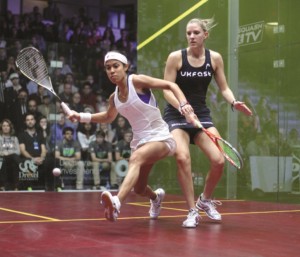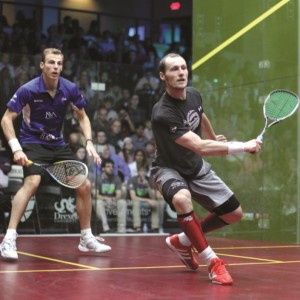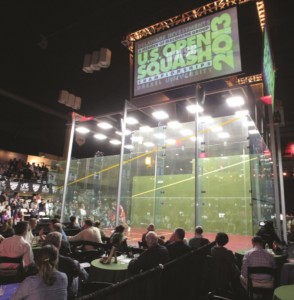 By James Zug
By James Zug
Parity was the watchword the entire nine days of the 2013 Delaware Investments U.S. Open at Drexel University. It was the first major tournament in the history of professional squash—now in its 110th year—to offer equal prize money for the players, regardless of whether they were a man or a woman.
It could even be argued that there actually wasn’t parity in the entertainment on court, for the women perhaps put on a greater show. Exhibiting depth, contrasting styles and wondrous shot-making, the women went the distance: there were twice as many five-game matches on the distaff side as on the men’s and, while the men’s five-gamers all came in the first or second round, half of the women’s came in the final three rounds when the tension sometimes became unbearable.
And there was a lot more American interest on the women’s side. Olivia Blatchford and Sabrina Sobhy qualified into the main draw; when added to the ageless Latasha Khan and precocious Amanda Sobhy, who earned spaces due to their world rankings, and Kristen Lange, who got the wild card spot, there were five American women in the main draw—the most since the women started playing the U.S. Open in 1993. The Americans all lost in three in the opening round except Amanda Sobhy who snagged a cliffhanger over Guyana’s Nicolette Fernandes, before going down in four to Malaysia’s Low Wee Wern. Low’s sister is a junior at Trinity College, and she had just spent a short week up in Hartford training with the team. Some of the dynastic Bantam mojo rubbed off on Low, as she made it to the semifinals before going down 11-7 in the fifth to Laura Massaro.

Nicol David, the Malaysian queen of squash and 2012 Open champion, was in her eighty-eighth straight month at world No.1 and running rampant, in her signature sneakers, through the draw until she bumped into Massaro in the finals. Massaro, an Englishwoman displaying grit and good length and receiv- ing solid advice from her coach and husband Danny, took David to five games in an eighty-four-minute marathon. It was very close. Massaro squandered two game balls in the first and was up 7-4 in the fourth with a 2-1 lead. “It took Nicol a long time to play through and figure out how to beat Massaro,” Liz Irving, David’s coach, said afterwards. “Luckily she survived long enough to do it.”
On the men’s side, the matches went more to form. Five Americans were in the qualifying tournament. Only Todd Harrity managed to win a match, in a seventy-five minute epic over England’s Chris Ryder on Harrity’s home court at Merion; Harrity lost in another equally long match the next night. In the main draw, both Chris Gordon and Julian Illingworth went quietly in three games.
Deprived of home interest, crowds delighted in seeing Australia’s Steve Finitsis’ sleight-of-hand deception, Germany’s Simon Rösner’s sweaty stubbornness (Rösner reached the quarters for the first time in a major tournament) and France’s Mathieu Castagnet’s flashing quickness. But it was a bit predictable: the semis had the four top seeds and the finals the top two; all four men are in their thirties—this could have been the same draw a decade ago. Moreover, James Willstrop still couldn’t solve the Nick Matthew riddle: the Englishmen have played sixteen times in PSA events in the past six years and Matthew has won all sixteen. (He has beaten Matthew twice, however, in league play in Germany.)
 France’s Gregory Gaultier, presently in the middle of the best stretch of his amazing career, cruised to the title without the loss of a game. Right now Gaultier is unafraid of anyone, except Egypt’s Ramy Ashour who chose to sit out the Open, and he simply overpowers opponents with his precision and ability to recover from all four corners of the court. “If he just plays one percent less, well, I have a shot,” said Matthew after the final, “but right now, crikey, Greg is on top form.” It is almost like he is in a year-long zone: I saw Gaultier one afternoon using up most of his half-hour of practice time on the glass court to ghost around alone, without a ball, just feeling his body moving through space.
France’s Gregory Gaultier, presently in the middle of the best stretch of his amazing career, cruised to the title without the loss of a game. Right now Gaultier is unafraid of anyone, except Egypt’s Ramy Ashour who chose to sit out the Open, and he simply overpowers opponents with his precision and ability to recover from all four corners of the court. “If he just plays one percent less, well, I have a shot,” said Matthew after the final, “but right now, crikey, Greg is on top form.” It is almost like he is in a year-long zone: I saw Gaultier one afternoon using up most of his half-hour of practice time on the glass court to ghost around alone, without a ball, just feeling his body moving through space.
Total prize money was $230,000. Gaultier received the same amount as 2012’s winner Ashour did. The difference was that Nicol David’s check was $6,000 more than last year. As the saying goes, the trophies were the same size—and so were the winners’ checks.
At the 2013 U.S. Open, technology reigned. Everyone tweeted and retweeted scores and comments. You could text answers for trivia questions up on the giant video screens. For the first time, the Open streamed the matches on the down- stairs, glass-back court, live on YouTube. With a chat room and in-between-games music, it kept everyone abreast. Of course, SquashTV broadcasted every point on the glass court, producing a beautiful and attractive event that was sent out live, for the semifinals and finals, on ESPN3 and by a dozen broadcast companies around the world.

New on the SquashTV side was the radio earpiece that enabled everyone to listen to the live commentating on SquashTV. It was like bringing a radio to a baseball game. You could see whole rows of radio-upped spectators guffawing to themselves when Joey Barrington or Paul Johnson cracked a funny joke or picked on David Pearson for his pastel shirts, or made a bold prediction on a referee’s video review. The signal was quite strong. One night to see how far it extended, I walked out of the Daskalakis Athletic Center itself, onto the U.S. Open-banner-bedecked Market Street (aptly called The Avenue of Technology) and made it two whole blocks down Market before the voices faded into static.
To fully saturate myself, I clicked up both the YouTube and SquashTV feeds side-by-side on my computer, the radio commentary in my ear and my hand on my smartphone refreshing my Twitter. Ah, a life on screens.
In person, the whole vibe at Drexel was richly textured. Mario the Magnificent Dragon—Drexel’s mascot—made his annual appearance. The crowds were larger—especially with Drexel students as the university flooded in to watch, even when there wasn’t free pizza. Autograph lines snaked around the expo area. Spectators, especially the younger sort, guessed how many balls were in a clear box, avidly played squash on the Wii and took a go at the speed gun (Australia’s Cameron Pilley’s record of 175mph remained intact). Players and parents from the Arlen Specter JCT tournament, the Howe Cup, the national intercollegiate doubles and the various NUSEA events took up seats too.
Before and after matches, dazzling splash patterns danced over the glass court, bathing it like a misty waterfall in full moonlight. The scene was even more spectral on the afternoon of the finals. I came up to the darkened arena a couple of hours before the matches began and heard the dulcet sound of a classical guitar on the public address system. It was Eric Zillmer, Drexel’s polymathic athletic director, sitting on a stool just in front of the T, strumming away in the silvery light, the entire arena otherwise silent and empty. Magical.
The U.S. Open has had a peripatetic existence since it was founded sixty years ago. Only once has it stayed in one place for longer than three years: when it was in Boston from 1998 until 2006. Now that moving around—from Minneapolis to Providence to Atlantic City—is over, at least until the far-off-sounding year of 2023. During this year’s edition, John Fry, the president of Drexel, and Kevin Klipstein of US Squash, announced a groundbreaking agreement to stage ten more U.S. Opens at Drexel. So at least thirteen consecutive Opens will be played in the University City neighborhood of Philadelphia. Ponder the other announcement: that by 2022, and probably before then, the total prize money package will exceed $1 million, taking the Open—and squash itself—into an individual-sport stratosphere hitherto only graced by the starry sports of golf and tennis. Maybe by then the issue about parity will be moot.





